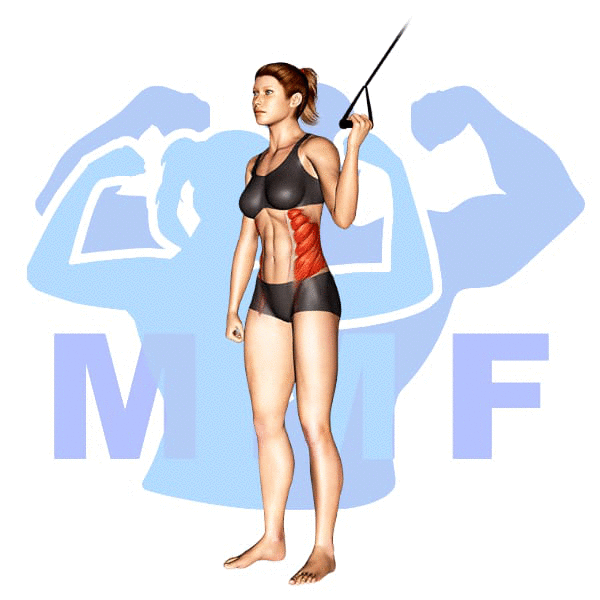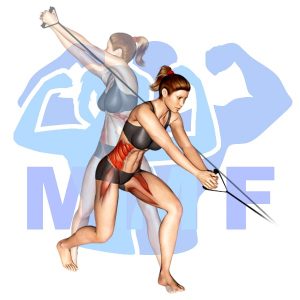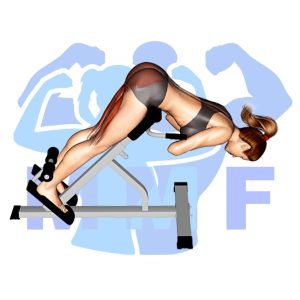Do you find yourself struggling to target your oblique muscles during your workout? Are you tired of doing basic crunches and not seeing the results you want in your midsection? Well, you are not alone. Many people experience difficulty when it comes to strengthening their core, especially their obliques. But fear not, because there is a solution – the resistance band side crunch. By incorporating this exercise into your routine, you can effectively target those hard-to-reach muscles and achieve your desired results. In this blog post, we will go over the proper form and technique for the resistance band side crunch, so you can add it to your routine and take your core workouts to the next level.
Resistance Band Side Crunch Summary
- Primary Muscles: Obliques
- Secondary Muscles: Quadratus lumborum, Psoas major, Iliocastalis lumborum, and Iliocastalis thoracis
- Equipment: Resistance Band and Door Anchor
- Mechanics Type: Isolation
- Force: Pull
- Utility: Auxiliary

Resistance Band Side Crunch Instructions
- Attach the resistance bands to a good anchor point above your head.
- Set your body up standing at a 90-degree angle from the band and anchor.
- Grab the resistance band handles with the hand that is closest to the anchor.
- Pull the band with your hand down to a level where it is tight.
- Then perform your crunch by pulling with your side obliques.
- After you have reached your maximum crunch, allow the band to pull your body back to vertical.
- Repeat these side crunches for 8-12 reps and then switch sides.
Video Tutorial
Resistance Band Side Crunch Muscles
Target (Agonist)
Synergists
- Quadratus lumborum
- Psoas major
- Iliocastalis lumborum
- Iliocastalis thoracis
Dynamic Stabilizers
- None
Stabilizers
- Latissimus Dorsi
- Teres Major
- Pectoralis Major – Sternal
- Pectoralis Minor
- Rhomboids
- Levator Scapulae
- Trapezius – Lower
- Triceps – Long Head
- Brachialis
- Brachioradialis
- Biceps Brachii
Antagonist Stabilizers
- None

Benefits of Resistance Band Side Crunch
Resistance Band Side Crunches are an excellent way to target the obliques, which are the muscles located along the sides of the torso. These muscles help to provide stability and strength in the core, and when worked regularly, can help create a strong, toned appearance. The Resistance Band Side Crunch is also a great exercise for improving posture, as it works to strengthen the deep muscles that support the spine. Additionally, this exercise helps to build core strength and stability, making it an important component of any strength training or fitness routine.
Tips for Performing Resistance Band Side Crunch
If you want to attain the optimum improvement use, these simple tips. Similarly, if you want to avoid injuries, follow these tips.
- Use Multiple Bands To Raise The Challenge. When you are easily performing 12 or more reps every exercise, then you ought to raise the level of resistance. You can either do this by stretching the band further at the outset of the exercise or by attaching more bands. The recommended method is to add some more bands since it is readily repeatable to have a similar resistance on each workout.
- Complete The Right Quantity Of Sets With Rest. Your target at first might be to do 3 sets to near fatigue. Although, you can raise to 5 sets. If your muscle tissue isn’t tired at the conclusion of 3 – 5, something needs to change. Initally, you can increase the resistance to make each repetition more difficult. Additionally, you can reduce the rest time between your sets.
Benefits and Tips Video
Frequent Mistakes To Avoid
You need to keep from making these regularly occurring mistakes to ensure nice form and muscle firming. Additionally
- Stop Cheating. Most of the time, cheating is utilizing momentum instead of the strength of your agonist (target) muscle tissue. Once in a while, a little bit cheating on your final rep can be beneficial to overload your muscle, although not for more than a handful of reps.
- Don’t use To Little or Too Much Tension. Not enough, and you will not be sufficiently using your target muscle, too much, and you will probably cheat. Make certain you can conduct between 8-12 reps with good technique.
Find More Resistance Band Exercises Here
Variations and Complementary Exercises
For those who would like to add variety to their Resistance Band Side Crunch routine, here are a few complementary exercises that work similar muscles:
Resistance Band Side Bends

Resistance Band Side Bends are an excellent complementary or alternative exercise to Resistance Band Side Crunches. This exercise is great for targeting the obliques and strengthening the core muscles. To perform this exercise, you stand with your feet shoulder-width apart and hold a resistance band in both hands. Slowly bend your torso to the right side, maintaining a straight back and hold for a few seconds. Return to the starting position and repeat on the left side. You can also use a single resistance band and loop it around your waist for added resistance. Resistance Band Side Bends help to develop stability, strength, and mobility in the core muscles, which is essential for overall fitness.
Resistance Band Pull Up Standing Twists

Resistance Band Pull Up Standing Twists is a great complementary exercise to Resistance Band Side Crunches. This exercise works your core, glutes, and obliques and helps strengthen your lower back. It targets the same muscle groups as Side Crunches but in a slightly different way. To perform this exercise, stand with your feet hip-width apart, holding the resistance band with both hands at chest level. Twist your torso to the left and right, keeping your core tight and arms straight. This exercise helps to improve balance and stability while working the same muscles as Side Crunches.
Resistance Band Pull Down Standing Twists

The Resistance Band Pull Down Standing Twists is an excellent complementary or alternative exercise to the Resistance Band Side Crunch. It is a full-body workout that works the shoulders, arms, and core muscles. This exercise requires you to stand with your feet shoulder-width apart while holding the resistance band with both hands. You will then twist your torso to one side while pulling the band down and across your body. This exercise not only strengthens your core muscles but also helps to improve balance and coordination. It can be used as a stand-alone exercise or as part of a larger workout routine.
Check Out These Top Resistance Band Exercises
Resistance Band Standing Twists

Resistance Band Standing Twists is an excellent complementary or alternative exercise to Resistance Band Side Crunches. This exercise is done by standing with your feet hip-width apart, holding a resistance band in both hands, and rotating your torso from side to side while keeping your arms straight. It is a great way to strengthen your core muscles and obliques, as well as improve your balance and coordination. It is also a great way to add variety to your core routine, as it can be done anywhere with minimal space and equipment.
Side Crunch

The Side Crunch is a great complement or alternative exercise to the Resistance Band Side Crunch. This exercise targets your obliques and abdominal muscles, helping you to build strength in those areas. It is performed by lying on your side with one arm placed behind your head and the other arm placed on the floor. From this position, you then crunch up and across your body while raising your shoulder off the floor. Make sure to keep your feet together and hips stacked on top of each other throughout the motion. This is an effective exercise to help you build strength in your core and help you reach your fitness goals.
Side Bridge Twist

The Side Bridge Twist is a great complementary exercise for the Resistance Band Side Crunch. This exercise helps to target the core and oblique muscles from a different angle, while improving flexibility and mobility in the hips. It involves lying on one side with both legs bent, the lower leg stacked on top of the upper leg and both feet together. The upper arm is placed on the floor in front of the body and the other arm is extended straight up. Then, keeping the hips still, twist the upper body towards the ceiling, using the core and oblique muscles. After a few repetitions, switch sides and repeat. By including this exercise in addition to the Resistance Band Side Crunch, you will benefit from a full-body workout that helps to build strength and stability.
Find More Abs Exercises Here
Opposing Complementary Exercises
For maximum benefit, it is important to include exercises that work the opposing muscles of the Resistance Band Side Crunch. This will help ensure all of your muscles remain balanced and provide a comprehensive workout. Here are some exercises you can include in your workout routine to complement the Resistance Band Side Crunch:
45 Degree Twisting Hyperextension

The 45 Degree Twisting Hyperextension is an excellent exercise to complement the Resistance Band Side Crunch. This exercise targets the lower back and oblique muscles by working them in an opposing motion. The 45 Degree Twisting Hyperextension strengthens the muscles that the Resistance Band Side Crunch works against, which helps to balance out the muscular forces in the body. This exercise will help build core strength and stability, as well as improve flexibility and coordination.
45 Degree One Leg Hyperextension

The 45 Degree One Leg Hyperextension is an effective exercise for strengthening the muscles in the lower back. This exercise works to oppose the Resistance Band Side Crunch by targeting the gluteus and hamstring muscles. The 45 Degree One Leg Hyperextension works to engage and strengthen the posterior chain, while the Resistance Band Side Crunch focuses on developing the abdominal muscles. By doing both exercises together, you can build a balanced physique with strong and toned muscles in both the front and back of your body.
45 Degree Hyperextension

The 45 Degree Hyperextension is a great way to target the muscles of the lower back and glutes. This exercise involves the user lying face down on an angled bench and lifting their upper body off the bench. This exercise works to strengthen the muscles of the lower back and glutes, which are opposing muscle groups to the abdominals used in a Resistance Band Side Crunch. By combining the two exercises, you can work to strengthen both sets of muscles, creating a balanced and strong core.
Get Toned Abs with the Resistance Band Side Crunch!
Looking to tone your abs? The resistance band side crunch is an effective exercise that targets the oblique muscles. By adding resistance with a band, you can increase the intensity of the exercise and see results faster. Make sure to use proper form to avoid injury and get the most out of each repetition. It’s important to warm up before starting any exercise routine and to consult a trainer or doctor if you have any concerns about your fitness level.
References: Wikipedia | ExRx.net | PubMed.gov | Comprehensive List of Abs Resistance Band Exercises

